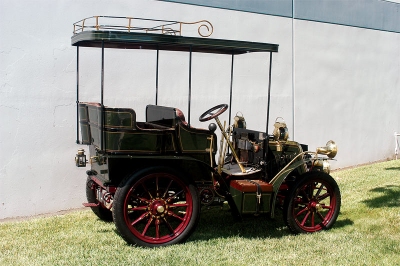SCM Analysis
Detailing
| Vehicle: | 1901 Panhard et Levassor |
| Number Produced: | 1,000 approx. (15 competed in 2005 London-Brighton Run) |
| Tune Up Cost: | Do it yourself or find a 100-year-old mechanic |
| Distributor Caps: | N/A |
| Chassis Number Location: | Cast plate on frame rail |
| Engine Number Location: | Side of crankcase |
| Club Info: | perso.wanadoo.fr/site.panhard/; www.club-panhard-france.com/sommaire.html; www.panhard-acplc.com/ |
| Investment Grade: | B |
This 1901 Panhard et Levassor Rear-Entrance Tonneau sold for $220,000 at the Gooding and Company Pebble Beach auction on August 21, 2005.
Panhard once claimed they were “la marque la plus ancienne du monde,” the oldest make of car in the world. Mercedes-Benz made the same claim but over time the two firms were able to resolve this discrepancy. Panhard and Mercedes were initially intertwined, as Panhard was a manufacturer of woodworking equipment and would have not gone into automobile manufacturing if the Daimler engine had not been available. So both manufacturers get “first car” bragging rights.
Panhard’s friend Armand Peugeot also used Daimler engines, and friendly competition improved both marques. Panhard was absorbed by Citroën in the 1960s and Peugeot bought Citroën a decade later.
Emile Levassor and Rene Panhard met as students in the 1860s and years later formed Panhard et Levassor with a contract to manufacture, under license, Daimler engines. They built their first automobile in 1890 and their first four-cylinder automobile in 1896, and by 1900 Panhard et Levassor was one of the world’s largest automobile manufacturers. Their plant, one of the most modern factories of the era, employed 800 workers who turned out about 75 cars a month. This, however, did not keep up with demand and deliveries were often 18 months out.
In 1897 Emile Levassor had a serious racing accident and subsequently died of his injuries. He was replaced by Arthur Krebs, who developed several important innovations for the Panhard, including a variable-speed carburetor and coil and battery ignition. He also developed the first true Panhard engine, the Centaure, with the 1.7-liter, two-cylinder version appearing in the A2 model in 1901 (some sources say 1900). The four-cylinder version displaced 15,435 cc and produced 100 hp.
The 1901 Panhard offered by Gooding and Company was the smaller two-cylinder, wood-bodied, rear-entrance tonneau with the Krebs-designed Centaure engine. It sold for $220,000, a figure that a few years ago would have been thought ludicrously high. Pundits declared that brass cars had one foot in the grave and Full Classics were not far behind. Their logic was simple: people collect the cars they coveted in their youth and those aspiring to own 100-year-old relics were maturing themselves out of existence.
But to paraphrase a well-known quotation, the reports of their demise were greatly exaggerated. The flaw in this logic is the increasing sophistication of collectors, and their growing understanding of the importance and appeal of cars that are historically significant-and can be driven as well.
Where do you take a 1901 Panhard? First stop would be the annual London-to-Brighton Commemorative Run that takes place the first Sunday in November. An average of 500 vintage automobiles built prior to January of 1905 brave the elements and depart Hyde Park in London for the 60-mile run on the A23 highway to the Sussex seaside resort of Brighton. The Run celebrates the 1896 repeal of the “Locomotive Act” and the raising of the speed limit from 4 to 14 miles per hour. The number of participants has been increasing annually and they come from around the world, with over a million spectators along the route.
U.S. buyers take note: Early car tours are far more prevalent in England, which seems to have a lock on quaint two-lane roads that wind through the countryside from pub to pub. Driving on the shoulder of I-84 to Eastern Oregon with semi-trucks and Dodge Ram pickups flying by doesn’t have the same appeal.
Was the price paid here out of line? In March 2000, Christie’s, at its Nine Elms London auction, sold a virtually identical 1902 Panhard for $116,070 (SCM Gold database #20686) and got double the money for a 1903 four-cylinder model, which brought $215,763 (SCM #5600). In London in 2003, Bonhams sold another 1902 two-cylinder car (same owner since 1905) for $150,156, (SCM #31808).
So can we tack on $100,000 in appreciation in a five-year span? Yes. When we consider the current market conditions and that this is a well-documented, sorted example of a significant vintage automobile, we have to say this should be considered well bought. And likely to keep going up in value as well.
